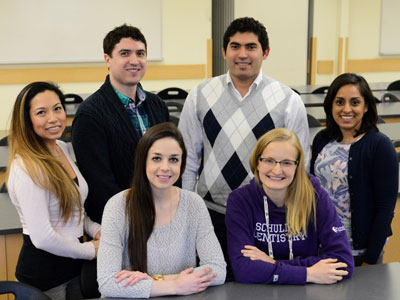DART Group aims to hit dental research bullseye
By Jesica Hurst, BA'14
After dedicating countless hours to scientific innovation and discovery during the completion of their PhD degrees, second-year dentistry students Kim Beaucage and Erik Holm came to the realization that their current clinical studies could have a stronger focus on and incorporation of dental research.
The two were determined to fill that void by bringing together a like-minded group of trainees with a common interest in dental research.
 In August 2015, they officially launched the Dental Academic Research Trainee (DART) Group. “DART is comprised of trainees from different fields and backgrounds who have an interest in dental research, and who are generally already involved in research at the School,” Beaucage said, adding that members currently include dentistry students, graduate trainees, postdoctoral fellows and internationally trained dentists. “This Group gives us an opportunity to get together and discuss ideas, and also have seminars and workshops that are relevant to research in some way.”
In August 2015, they officially launched the Dental Academic Research Trainee (DART) Group. “DART is comprised of trainees from different fields and backgrounds who have an interest in dental research, and who are generally already involved in research at the School,” Beaucage said, adding that members currently include dentistry students, graduate trainees, postdoctoral fellows and internationally trained dentists. “This Group gives us an opportunity to get together and discuss ideas, and also have seminars and workshops that are relevant to research in some way.”
The seminars and workshops are meant to supplement the training they already receive, and help bring their research efforts to the real world. They also focus on additional skills they will need to bring to the table throughout their careers, and what they think they can address during their own student-run events.
“Groups like DART need to exist to help increase communication and
collaboration between dentists and the researchers.”
— Erik Holm
In the short time that DART has existed, they have already hosted two successful events. The first was open to all dentistry trainees and featured Ivey Business School’s Mary Crossan, PhD, who discussed how to hone individual leadership skills. The second was a lunch and learn event that featured Dr. Jake Bartlett from McGill University who discussed translational research, innovation and industry, and entrepreneurship.
The DART Board meets approximately once a month to discuss their future goals.
Beaucage and Holm created the DART Group to bring people together to discuss new dental research ideas and to hopefully initiate potential collaborative research projects.
“Research in the field of dentistry is really wide open — there is so much that can be done, but so little is currently being done,” Holm explained. “Groups like DART need to exist to help increase communication and collaboration between dentists and the researchers.”
Yara Hosein, PhD, a postdoctoral fellow currently working on dental research, agrees. She joined the DART board upon its inception and explained that it has been great working with dentistry students as a researcher, because it helps to provide information she doesn’t have with an engineering background.
“I could spend months trying to determine what an important dental research question might be. But when I speak to Kim, Erik or other dentistry students in the Group, within one conversation we come up with a few ideas we could work on,” Hosein said. “These conversations we have benefit both sides, so it’s a really good marriage of skills.”
Schulich Dentistry has seen its fair share of dental research groups before, but Holm explained they usually last a few years then die out until someone wants to pick it up again.
He and Beaucage believe that the DART Group will be successful by recruiting people who are consistently interested in research, and by creating more awareness of the Group amongst dentistry students.
They are also developing a transition plan for the Group that includes members from different years and research backgrounds.
“We just need to keep finding people who are just as passionate about dental research as we are. It’s how this Group will continue to thrive,” Beaucage said.








